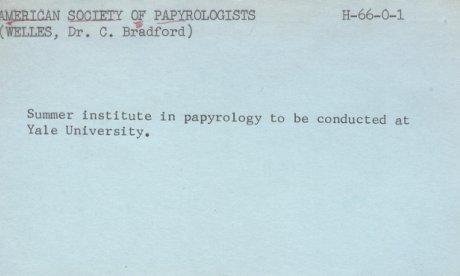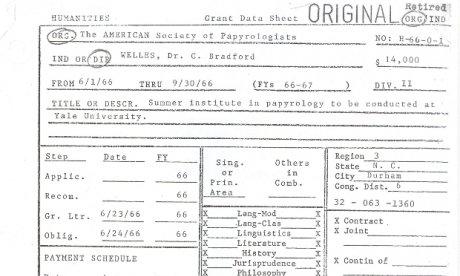Digitizing NEH's Early Grant Records: Our First Grant

Index card from the NEH files documenting our very first grant.

Index card from the NEH files documenting our very first grant.
We're embarking on this cool new project to digitize all our early grant records between 1965 (when the agency was founded) and 1980 (when we first began using a computer to process grants). I'd like to introduce you to Ann Sneesby-Koch, who is working right here in ODH HQ and helping us on this project. Ann has an MS in Information Science from the University of Tennessee-Knoxville and an MA in Classical Studies from the University of Maryland. We're super-pleased to have her on board running this project for us. I've asked Ann to blog periodically on how her work is progressing. When done, you'll be able to search all NEH grants right back to our founding. Let me kick things off with just a bit of background on what we're doing.
As the NEH's Chief Information Officer, one of my main goals has been to make NEH grant data as widely available as possible. The NEH didn't computerize its grant data until 1980 when we acquired our Wang-based grants system called Augustus. Then around 1997 (when I started at the NEH), we started moving all the old data to an SQL-based system. Today, we keep all that data (and much more) in a Microsoft SQL Server database, which we access using various tools and applications. My Office of Information Resources Management (OIRM), under the direction of my long-time colleague Tanya Peltz, runs all our systems and codes most of our grants software in-house. About four years ago, at the beginning of President Obama's administration, we began a process of releasing all of our data to the public in numerous formats.
Most of you probably know about our Funded Projects Query Form (FPQF) that allows you to search for any grant (back to 1980, for now). I blogged about it here. You may know that we've also exported all the grant data into XML format and placed it on Data.gov, which is part of the White House's Open Data Initiative. With these XML files, you can download all the data in bulk and repurpose it, mine it, study it, or create huge poster-sized printouts for your ping pong room. Then last year, we launched a new crowdsourcing project called Products, Prizes, and Media Coverage to help us link every grant to the books, articles, films, exhibits, prizes, or other things that came out as a result. I blogged about that here.
For this new digitization project, Ann has been working with me and Peter Losin from OIRM and Frank Shaw from our Office of Planning and Budget. She is carefully going through all of our old, paper-based grant files and keying them into our system. When finished, you'll be able to seamlessly access all of our grants going back to our founding in 1965. Over the course of the next few months, Ann will periodically blog about her progress and some of the interesting things she's discovering. To kick things off, check out the attached image, a copy of the very first grant made by the NEH. Back then, our "computer" was a blue index card and a one-page data sheet. I suspect the papyrologists out there will be pleased to see that our first grant was to fund a summer institute organized by the American Society of Papyrologists. Note the grant number: H-66-0-1. (By the way: If you know anyone who attended that institute or have any information about it, please get in touch!)
